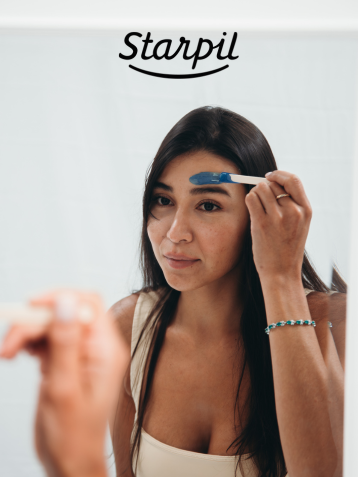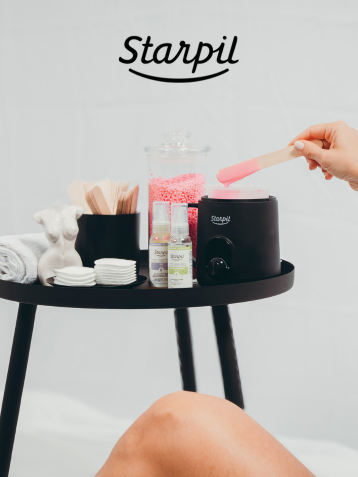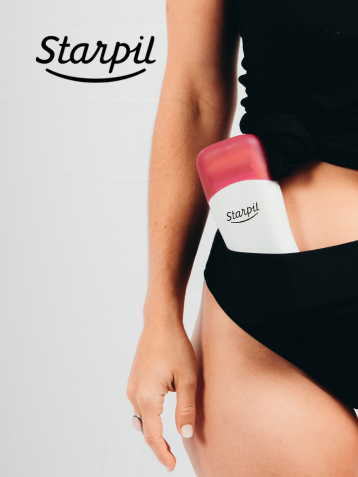How to Get Rid of Ingrown Hairs: Expert Tips

If you've recently started waxing, you might have encountered a common but frustrating issue: ingrown hairs. These pesky little bumps can be uncomfortable and unsightly, but don't worry – with the right knowledge and techniques, you can prevent and treat them effectively.
Table of Contents
In this guide, we'll share expert tips on how to keep your skin smooth and ingrown-free. If you’ve already gotten an ingrown hair or two, we’ve also included treatment strategies to get rid of them quickly.
READ: Can You Shave Between Waxing?

Understanding Ingrown Hairs
Before we dive into prevention and treatment, let's understand what ingrown hairs are. An ingrown hair occurs when a hair grows back into the skin instead of rising up from it. This can happen when hair is cut or removed in a way that allows it to curl back into the skin as it regrows. Ingrown hairs can cause inflammation, redness, and sometimes even infection.
READ: When Does Armpit Hair Grow? Hair Growth for Underarm Waxing
How to Prevent Ingrown Hairs
Preventing ingrown hairs before they form is the best way to keep your skin in its best condition. The following techniques will help stop ingrowns from forming after hair removal:
Proper Pre-Wax Preparation
The key to preventing ingrown hairs starts before you even apply the wax:
- Exfoliate gently 24-48 hours before waxing to remove dead skin cells.
- Ensure your hair is the right length (about 1/4 inch) for effective waxing.
- Clean the area thoroughly to remove any oils, bacteria, or dirt.
- Apply a Pre-Wax Gel to cleanse skin before your session.
Use High-Quality Wax
Not all waxes are created equal. Using a high-quality wax, like those offered by Starpil Wax, can make a significant difference:
- Look for waxes formulated to grip the hair, not the skin, like hard wax.
- Hard waxes are often gentler and more effective for sensitive areas prone to ingrowns.

Perfect Your Waxing Technique
Proper waxing technique is crucial for preventing ingrown hairs:
- Apply wax in the direction of hair growth.
- Remove the wax against the direction of hair growth in one quick motion.
- Hold the skin taut while removing the wax to ensure complete hair removal.
Post-Wax Care
What you do after waxing is just as important as the waxing itself:
- Apply a Post-Wax Oil to remove wax residue and hydrate skin.
- Apply a Post-Wax Lotion to soothe the skin and moisturize.
- Avoid tight clothing for 24-48 hours to allow the skin to breathe.
- Stay out of hot showers, saunas, and direct sunlight for at least 24 hours.
- Avoid activities that might cause sweating or friction for at least 24 hours, including exercise and sex.
- Apply an Ingrown Hair Serum 24 hours after waxing to cleanse the skin and dissolve ingrowns before they form.
Regular Exfoliation
Keeping your skin exfoliated between waxing sessions is key:
- Start exfoliating 24-48 hours after waxing, then 2-3 times a week.
- Use a gentle scrub or exfoliating glove to remove dead skin cells.
- Focus on areas prone to ingrown hairs, like the bikini line or underarms.
READ: Waxing 101: Which Direction Should You Pull the Wax?

How to Treat Existing Ingrown Hairs
Despite your best efforts, you might still encounter an ingrown hair. Here's how to treat them safely:
It's tempting, but resist the urge to pick at or squeeze ingrown hairs:
- This can lead to infection and scarring.
- Instead, try the following gentle treatments.
A simple but effective treatment:
- Apply a warm, damp cloth to the affected area for a few minutes.
- This can help soften the skin and encourage the hair to come to the surface.
Once the area is no longer irritated:
- Use a gentle exfoliating scrub.
- Move in circular motions to remove dead skin and help the hair break through the surface.
24 hours post-wax, apply an Ingrown Hair Serum to dissolve ingrowns before they form.
- Clears dirt and bacteria and gently exfoliates the skin.
- Dissolves hairs trapped underneath the skin’s surface.
Known for its antibacterial properties:
- Mix a few drops of tea tree oil with a carrier oil like coconut oil.
- Apply to the affected area with a cotton swab.
- Do this once or twice daily until the ingrown hair heals.
This beta-hydroxy acid can help exfoliate the skin:
- Use a product containing 1-2% salicylic acid.
- Apply to the ingrown hair area once daily.
- Be cautious if you have sensitive skin and always do a patch test first.
For particularly inflamed or itchy ingrown hairs:
- Apply a small amount of over-the-counter hydrocortisone cream.
- Use sparingly, as overuse can thin the skin.

When to Seek Professional Help for Ingrown Hairs
While most ingrown hairs can be treated at home, some situations warrant professional attention:
- If an ingrown hair becomes infected (increased redness, swelling, or pus).
- If you have chronic ingrown hairs that don't respond to home treatment.
- If you notice any changes in the appearance of moles or skin surrounding ingrown hairs.
Long-Term Ingrown Hair Prevention Strategies
To minimize ingrown hairs in the long run:
- Use hard wax for hair removal, which is gentler on the skin.
- If you have particularly sensitive skin, use a formula created specifically for your skin type.
- Maintain a consistent waxing schedule to train your hair growth.
- Stay hydrated and eat a balanced diet to promote healthy skin and hair growth.
- Wear loose, breathable clothing, especially in areas prone to ingrown hairs.
- Consider using a daily chemical exfoliant between waxing sessions to keep pores clear.
READ: Exfoliation After Waxing: When and How to Do It Right
Final Thoughts
Dealing with ingrown hairs can be frustrating, but with these expert tips, you're well-equipped to prevent and treat them effectively. Remember, consistency is key—stick to a good skincare routine, use high-quality waxing products, and be gentle with your skin. With time and practice, you'll master the art of smooth, ingrown-free skin.
At Starpil Wax, we're committed to helping you achieve the best waxing results, regardless of your skill level. Our range of salon-quality waxes and pre and post-wax care products are designed to minimize irritation and ingrown hairs, giving you salon-quality results in the comfort of your own home.






Comments